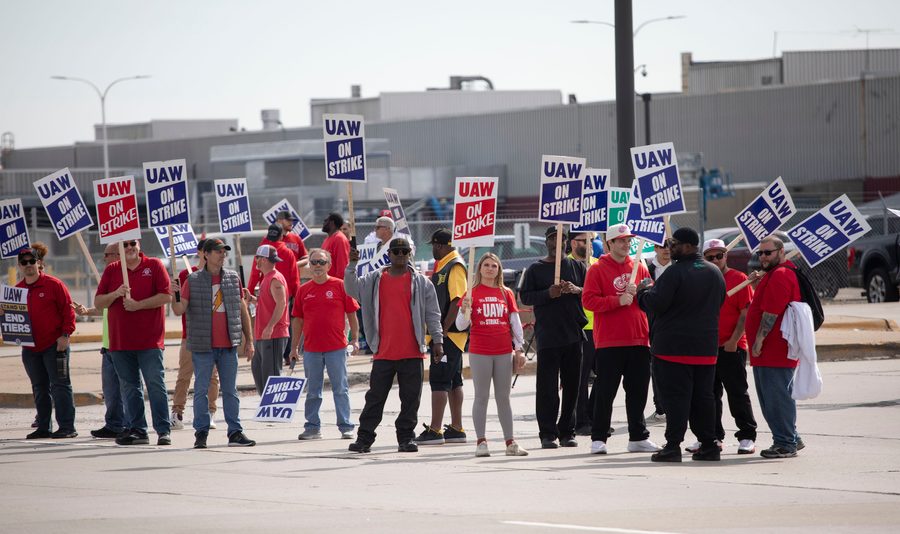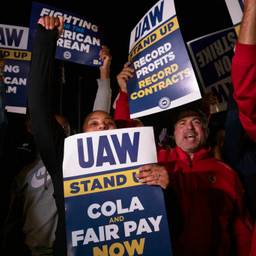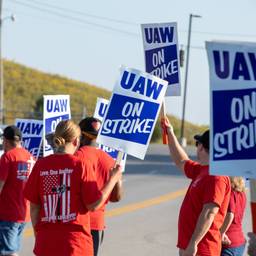The Big 3 Want You To Think Striking Workers and the Climate Are at Odds. They’re Not.
Mainstream media coverage of the UAW strike has implied that workers’ demands stand in conflict with achieving climate goals. That’s BS.
Sarah Lazare

In recent media coverage of the United Auto Workers’ stand-up strike against the Big Three car makers — Stellantis, Ford and General Motors — a false narrative is circulating: that the walkout is in conflict with the urgent need to mitigate climate change. The basic argument is that if wages and benefits were to improve, this would make the transition to electric vehicle manufacturing unprofitable, and would therefore imperil a centerpiece of President Joe Biden’s environmental policy.
“Union demands would force Ford to scrap its investments in electric vehicles, Jim Farley, the company’s chief executive, said in an interview on Friday,” reporter Jack Ewing wrote for the New York Times on September 16. Ewing goes on to quote Farley saying, “We want to actually have a conversation about a sustainable future, not one that forces us to choose between going out of business and rewarding our workers.”
In an article that ran on September 13, the day before the strike began, New York Times reporter Noam Scheiber put it similarly: “The companies say that even if they could raise wages for battery workers to the rate set under their national U.A.W. contract, doing so could make them uncompetitive with nonunion rivals, like Tesla.”
These reports echo the talking points of the same companies that have had a direct hand in slowing the transition to electric vehicles. All of the Big Three automakers are members of the Alliance for Automotive Innovation, a trade group, that lobbied against a proposed Biden administration rule to require that two out of three new passenger cars sold in the United States are electric vehicles by 2032.
These companies have also played a key role in fueling climate change. Scientists at Ford and General Motors knew about the impacts of global warming as early as the 1960s, yet the companies intensified their fossil-fuel heavy business model, turning to the manufacturing of trucks and SUVs over the ensuing decades while donating “hundreds of thousands of dollars to groups that cast doubt on the scientific consensus on global warming,” as revealed in a 2020 investigation by E&E News. Ford, General Motors and Fiat Chrysler (now owned by Stellantis) are among “the strongest opponents of regulations to help countries meet the 1.5C warming limit in the Paris agreement,” according to an investigation by The Guardian published in 2019.
Yet this vital context is largely being left out of ongoing coverage and, instead, companies’ supposed concerns about the environment are being reported at face value.
“Personally, I have no patience for the industry framing that workers are somehow responsible for slowing down the transition to EVs,” says Sydney Ghazarian, an organizer at the Labor Network for Sustainability, who has been leading the UAW solidarity effort from within the climate movement.
“It wasn’t auto workers who suppressed global warming research beginning in the 1960s while also lobbying against climate protections,” Ghazarian added. “It wasn’t auto workers who made the decision to produce gas-guzzling vehicles, or to locate pollutive plants in working class communities of color. Those decisions were made by auto industry bosses like Mary Barra, Jim Farley, and Carlos Tavares (the CEOs of General Motors, Ford, and Stellantis, respectively) whose primary motive was ensuring they could pocket millions and millions of dollars a year, at any moral, societal or planetary cost.”
The overwhelming majority of electric vehicle plants in the United States don’t have unions, and offer poor wages and benefits, even though this sector has received billions of dollars in subsidies from the Biden administration. The UAW has been advocating for improvements to pay and conditions across the sector, and would like to see electric vehicle workers benefit from the higher standards associated with unions. Auto industry leaders, meanwhile, have asserted that EV workers are not covered by UAW national contracts with the Big Three because their plants are joint ventures with foreign companies, and are therefore separate legal entities. “In practice, the reclassification scheme amounts to the Big Three in real time racing to the bottom before the electric transition in automotive manufacturing has fully taken place,” writes Jarod Facundo for The American Prospect.
As a result of this “joint venture” status, the ongoing strike that affects 150,000 UAW members does not directly involve this sector. But the implications for the electric vehicle industry are almost certainly on workers’ minds as they fight for demands such as improved pay and paid time off, the eradication of tiers, and an end to the mistreatment of temporary workers. A victory for auto workers would likely buoy their offers to unionize the electric vehicle sector, or, at the very least, help set higher standards.
An August 21 article published in Axios states, “A potential strike by U.S. auto workers in September would be a high-stakes problem for President Biden, who’s trying to balance his push for electric vehicles with his self-description as ‘the most pro-union president ever.’” (It’s worth noting that Axios lists General Motors as a corporate partner.)
The idea that the strike stands in conflict with the Biden administration’s transition to electric vehicles is being repeated across the U.S. media ecosystem. A September 18 article published in Politico begins, “The United Auto Workers strike is likely to have at least one winner: Elon Musk. And that spells trouble for President Joe Biden’s efforts to shape the auto industry’s future.”
Another Politico article that quoted climate activists who support the UAW strikers’ demands still implied that the strike could harm the electric vehicle sector, running under the headline, “UAW strike could disrupt EV rollout. Environmentalists support it anyway.” The story ends with a quote from Mona Dajani, a lobbyist for Tesla, which is the top electric vehicle manufacturer in the United States and is fully non-union: “A UAW strike would put the brakes on current significant progress that’s being made with the automotive industry, in particular, in clean energy with EVs, with batteries, with all the supply chain to those.”
The supposed need to protect electric vehicle profits is even being used to justify the Big Three’s failure to disburse its profits to workers. The three companies made $21 billion in the first half of 2023. As Adam Johnson noted for The Lever, CNBC reporter Phil Le Beau asserted in a segment aired ahead of the strike that the companies “need those profits in order to fund the development of electric vehicles,” implying that this is why the companies can’t meet workers’ demands.
We should not take at face value the companies’ claims that improving labor standards is what stands in the way of electric vehicle profitability. Worker advocates have argued repeatedly that labor is a small fraction of the cost of producing an electric vehicle, and that labor costs should not be held responsible if the industry were to fail to take off.
Mijin Cha, an assistant professor of environmental studies at the University of California-Santa Cruz, says, “The Big Three all currently have union contracts. They are making record profits while also having a union workforce. It’s unclear to me why the EV sector can’t also make profits while paying workers well. We must reject the idea that the only way to transition to a low-carbon or carbon-free future is by exploiting workers.”
But even if the automakers’ claims were true, why would it be the responsibility of the workers to sacrifice their health, livelihood, and wellbeing for the sake of protecting these profits? Surely there’s a better pathway to an energy transition than continuing the status quo of injury, abuse, and low pay that is endemic in the electric vehicle sector.
Last year, workers at Rivian Automotive Inc., an electric vehicle manufacturer, complained to federal regulators about a host of alleged safety hazards and negligence that resulted in broken bones, a crushed hand and a sliced ear. That same company hired subcontractors that stole wages from Mexican laborers, resulting in two lawsuits and massive settlements. As climate report Kate Aronoff recently noted, the mistreatment of workers is rampant in this sector.
Are the executives of Ford, General Motors, and Stellantis volunteering to go work for Rivian Automotive under these conditions to hasten the electric vehicle transition they supposedly believe in? Is Farley volunteering to send his children into that company’s Bloomington-Normal factory to earn non-union wages and benefits? No. The CEOs of these three companies made a combined total of $74 million last year. When they talk about how sacrifices have to be made for the companies’ profitability, they’re talking about other people’s sacrifices.
This is a sore subject for UAW because when the government bailed out the auto industry in 2008 and 2009, the outcome brought devastating changes to the union’s contract, including a two-tiered wage system in which workers hired after 2007 were paid far less than those hired before. Workers were told at the time they needed to make sacrifices for the survival of the industry. Fifteen years later, they’re being fed that same message again amid record profits for their employers.
Within certain climate and labor circles, it’s long been an organizing tenet that workers’ interests do not need to be pitted against environmental wellbeing. Rather, a transition away from fossil fuels can go hand-in-hand with economic justice and gains for workers — a necessary precondition if climate organizers hope to build the kind of mass movement needed to shift the political reality in this country. “For the transition off fossil fuels to succeed, it’s imperative that it is a just transition that can convince millions of people to take the leap of faith into the new green economy,” said Joshua Dedmond, co-director at Labor Network for Sustainability, in a press statement.
Ghazarian warns, “A clean energy transition where CEOs pocket billions in profit from taxpayer subsidies while simultaneously breaking union power and pushing workers into economic insecurity is a pathway to political backlash.”
If Biden’s environmental program is premised on handing billions of dollars to companies that keep labor standards in the electric vehicle industry low, maybe it is time for a conversation about what a more robust model could look like. There are other avenues to achieving the transition to fossil fuels required to stave off the most catastrophic climate change scenarios. An alternative is massive public investment in an economic transformation that is not premised on the abuse of workers. Perhaps the headlines should instead read, “Auto Executives’ Failure to Improve Labor Standards Raise Questions About Whether They Are the Best Stewards of an Energy Transition.”
“The Inflation Reduction Act is not a Green New Deal,” says Ghazarian. “It was a historic investment in the energy transition, primarily in the private corporations that are responsible for driving the problem in the first place. This is in contrast to a Green New Deal, which has a vision of massive investments in the public sector, communities, and green jobs.”
Cha underscores, “One of my criticisms of the IRA is this misplaced faith in the private sector, the idea that if we give them enough money they will do the right thing. Corporate profits will always come first, executive pay comes second, and then somewhere far down the line is worker consideration. But without workers, none of this would happen,” she adds. “You could have a bunch of CEOs in a room, but without workers, no profits would be made.”
The UAW’s Fain, for his part, has regularly used the language of a just transition, and spoken openly about the need to address the climate crisis, earning him the support and enthusiasm of some climate leaders. “Our tax dollars are financing a massive portion of this transition to E.V. We believe in a green economy,” Fain told Face the Nation on September 17. “We have to have clean water. We have to have clean air. Anyone that doesn’t believe global warming is happening isn’t — isn’t paying attention.”
“But this transition has to be a just transition,” he added. “And a just transition means, if our tax dollars are going to finance this transition, then labor can’t be left behind. And, as it stands right now, the workers are being left behind. The companies want to talk about being competitive.”
Yet, news articles have baselessly generalized that auto workers oppose the electric vehicle sector, because manufacturing requires less labor, and therefore less jobs (a claim that has been disputed by some research). “For workers, the biggest concern is that electric vehicles have far fewer parts than gasoline models and will render many jobs obsolete,” New York Times reporter Ewing writes.
“Climate groups have been on many calls with members and leadership of the UAW, and have never heard anything from them about opposing electric vehicles,” Jeff Ordower, North America Director for 350.org, told In These Times and Workday Magazine. “They talk about understanding the transition is coming and having a just transition.”
The UAW does not oppose electric vehicles, and the cumulative effect of this misleading coverage is that, when it comes to the environment, the companies seem like forces of progress, while workers are portrayed as backwards. This framing can only assist the Big Three executives, which are no doubt eager to peel liberal support away from the strike (75% of Americans side with the UAW over the auto giants).
Chris Viola, a GM worker in Michigan, and a member of UAW Local 22 and the rank-and file movement Unite All Workers for Democracy, told Workday Magazine and In These Times that the industry’s framing does not comport with reality. “To be honest, I’ve actually noticed that environmentalists are supportive of the auto workers,” he says. “They’re not taking the bait, the green groups. I don’t see it at all.”
He says this moment has felt like an opportunity for solidarity between labor and environmental groups. “We have an opening, because we are one of the affected jobs for the transition, and if we don’t take this opportunity now, we will be left behind.”
There have been instances where parts of the labor movement have opposed environmental measures, but overstating these fractures will likely only deepen this divide. Today, there are some hopeful signs of bridge building between climate and labor movements. The UAW’s open embrace of a just transition, and willingness to talk about climate change, has been welcomed as a real opportunity by climate activists. And with the stand-up strike, which has seen nearly 13,000 workers walk off the job, climate groups have an opportunity to make overtures and build trust and relationships within the labor movement.
“We do not have to choose between good jobs and green jobs,” said Trevor Dolan, industry and workforce policy lead at Evergreen Action, in a press statement. “Corporate titans will try to split our movement by presenting us with a false choice.”
More than 100 climate and environmental groups have signed an open statement expressing solidarity with the UAW, which says, “We firmly support the UAW members’ demands and believe that the success of these negotiations is of critical importance for the rights and well-being of workers and to safeguard people and the environment.” And on September 13, a group of climate organizers traveled to Detroit to hold a rally at the 2023 North American International Auto Show to raise support for the UAW’s demands.
Ghazarian says that while the company’s narratives may be getting attention in the press, “I and the other climate groups are aware of this old trick, and we’re not falling for it.”
This article is a joint publication of In These Times and Workday Magazine, a non-profit newsroom devoted to holding the powerful accountable through the perspective of workers.
Sarah Lazare is the editor of Workday Magazine and a contributing editor for In These Times. She tweets at @sarahlazare.











